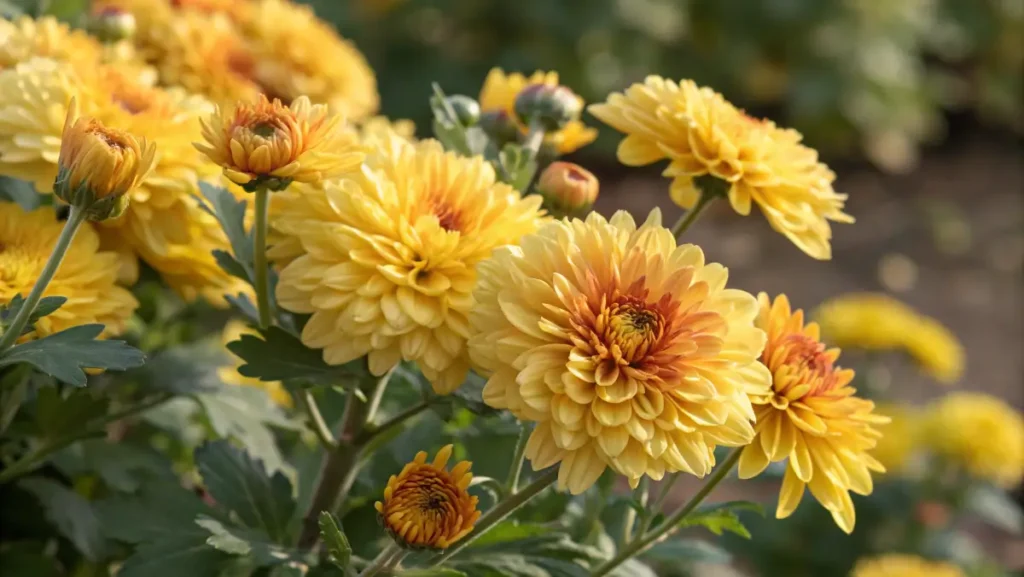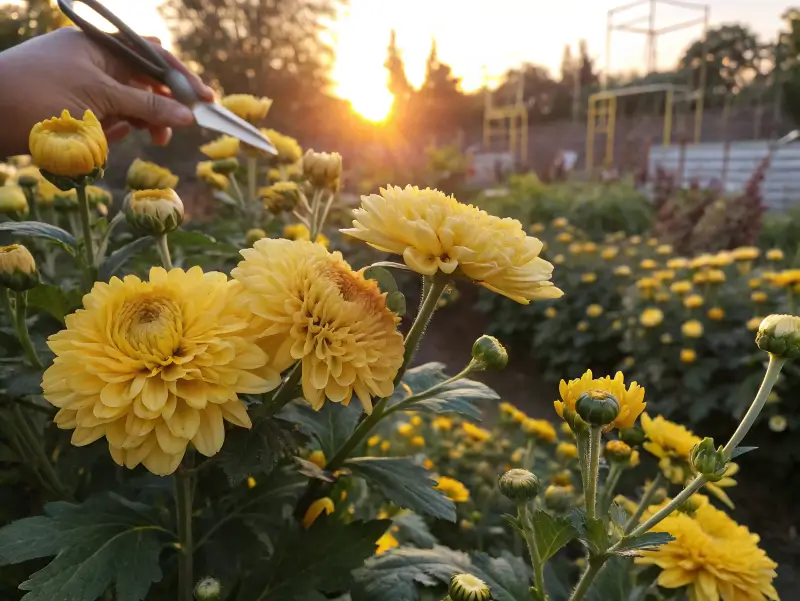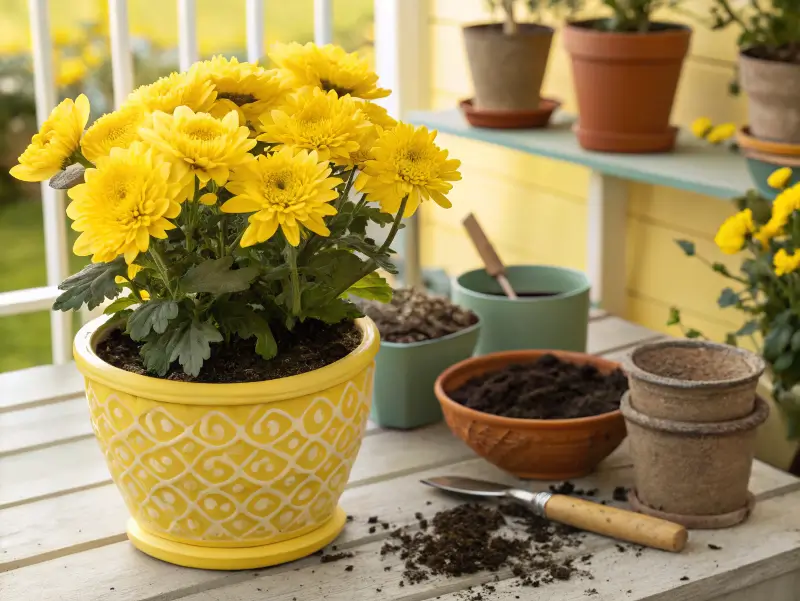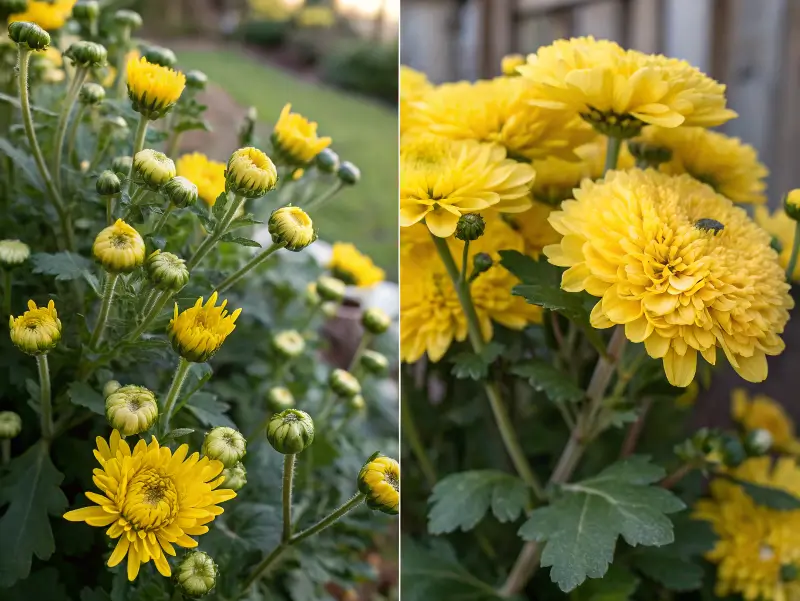
In This Article
The yellow chrysanthemum (Chrysanthemum morifolium), commonly known as garden mums or fall mums, brings vibrant sunshine to gardens with its cheerful golden blooms. These hardy perennials are beloved for their abundant daisy-like flowers that create stunning autumn displays. With a moderate growth rate reaching 1-3 feet tall and wide, yellow chrysanthemum plants thrive in full sun with consistent moisture. While generally safe around pets in small quantities, they can cause mild stomach upset if consumed in large amounts.
Yellow Chrysanthemum Care
Let’s face it—caring for mums isn’t rocket science, but there are definitely some tricks that’ll make your yellow beauties absolutely shine. I’ve been growing these gorgeous fall stars for years, and honestly, once you get the basics down, they’re pretty forgiving plants.
Light Requirements
Your yellow chrysanthemum plants are total sun worshippers. They need at least 6 hours of direct sunlight daily to produce those show-stopping blooms we all love. However, if you live in a super hot climate, a bit of afternoon shade can actually help prevent your plants from getting stressed.
Morning sun is absolutely crucial for yellow chrysanthemum success. Without it, your plants will get leggy and produce fewer flowers.
Watering Needs
Here’s where many gardeners go wrong: yellow chrysanthemum plants like consistent moisture, but they absolutely hate wet feet. Think of it like watering your favorite houseplant—you want the soil moist but not soggy.
I usually water deeply once or twice a week, depending on rainfall. The key is to water at soil level rather than overhead watering, which can lead to fungal issues. During hot summer months, your yellow chrysanthemum may need to be watered more frequently.
Soil Conditions
Well-draining soil is non-negotiable for healthy yellow chrysanthemum growth. Your ideal soil should be rich in organic matter, pH between 6.0-7.0, and have a loose, crumbly texture.
If you’re dealing with heavy clay soil, just work in some compost or coarse sand to improve drainage. Your yellow chrysanthemum plants will thank you for it.
Temperature and Humidity
Most garden mums are surprisingly tough cookies. They’re hardy in zones 4-9 and prefer moderate humidity levels. During hot summer days, providing some afternoon shade can help prevent heat stress.
Fertilizer Application
Feeding your mums is like feeding a teenager—they need regular meals during their growing season. I start with a balanced fertilizer (10-10-10 works great) in early spring when new growth appears.
Throughout the growing season, I feed them monthly with liquid fertilizer. However, I stop fertilizing about 6 weeks before the first expected frost to help plants prepare for winter.
Types of Yellow Chrysanthemums
Honestly, the variety of yellow mums available today is just incredible! When I first started gardening, you had maybe three options. Now? The choices are almost overwhelming—but in the best possible way.
Popular Yellow Varieties
‘Matchstick’ is hands down one of my favorites. These unique mums have spoon-tipped petals that look exactly like tiny matchsticks. The yellow color is bright and cheerful, perfect for fall container displays.
**’Yellow Jacket’ produces those classic pompom flowers that scream autumn. They’re incredibly reliable bloomers and work beautifully in both garden beds and pots.
For something different, try ‘Autumn Fire.’ These beauties have a bronze-yellow blend that creates this gorgeous sunset effect. They’re particularly stunning when planted alongside Red Geraniums for a warm autumn color palette that complements yellow chrysanthemum blooms perfectly.
Flower Forms and Classifications
The world of mum flower forms is fascinating! You’ve got decorative types with full, rounded blooms, daisy types with simple, cheerful faces, and button mums perfect for smaller spaces.
Spider mums have those wild, quilled petals that add texture and movement to fall displays. Each form brings something unique to your garden design.
Size Categories
Size matters when planning your garden layout. Dwarf varieties stay under 12 inches and are perfect for containers. Medium varieties (12-24 inches) are probably the most versatile, working great in mixed borders with other fall favorites like Butterfly Ranunculus.
Tall yellow chrysanthemum varieties over 24 inches make fantastic background plants, though they might need staking in windy areas.
Pruning

Pruning mums might seem intimidating at first, but it’s actually pretty straightforward. I like to think of it as giving your plants a really good haircut—it keeps them looking neat and encourages better growth.
Spring Pruning
After the last frost has passed, it’s time for spring cleanup. I usually wait until I see new growth emerging from the base before cutting back the old stems. Cut the old stems down to about 2-3 inches above ground level using clean, sharp pruning shears.
Summer Pinching
Here’s where the magic happens! Starting in late spring, I pinch the tips of my yellow chrysanthemum stems every few weeks until about mid-July. This encourages bushier growth and more flower buds.
Simply pinch off the top 1-2 inches of each stem with your fingers. The key is to stop pinching by mid-July at the latest, otherwise you’ll remove the flower buds.
Deadheading Practices
Removing spent blooms keeps your yellow chrysanthemum looking fresh and encourages continued flowering. I check my plants every few days during peak bloom season and snip off any faded flowers back to the first set of healthy leaves.
Propagating Yellow Chrysanthemums
Want more mums without breaking the bank? Propagation is your friend! I’ve probably tripled my mum collection over the years just by dividing and taking cuttings.
Division Method
Spring division is the easiest way to multiply your yellow chrysanthemum plants. Wait until you see new shoots emerging in spring, then carefully dig up the entire clump. Using a sharp spade, divide the clump into sections, making sure each piece has both roots and shoots.
I usually get 3-4 new plants from each mature clump. The best part? Divided plants often bloom better than the original because they’re not competing for space.
Stem Cutting Propagation
Taking stem cuttings is perfect for preserving specific varieties. In late spring or early summer, cut 4-6 inch pieces from healthy, non-flowering stems. Remove the lower leaves and dip the cut end in rooting hormone.
Plant the cuttings in a mixture of perlite and peat moss, keeping them consistently moist. Within 3-4 weeks, you should see new root growth.
Potting and Repotting Yellow Chrysanthemums

Container growing opens up so many possibilities for mums! I love being able to move pots around to catch the best light or create instant fall displays.
Container Selection
Size matters when choosing pots for mums. I typically use containers at least 12-14 inches wide for single plants. Make sure your containers have drainage holes—this is non-negotiable!
Terracotta pots are great because they breathe, but they dry out faster. Plastic containers hold moisture longer but can get hot in direct sun.
Potting Mix Requirements
A good potting mix is crucial for container success. I use a high-quality commercial mix designed for containers, usually something with perlite for drainage and organic matter for nutrition.
Never use regular garden soil in containers—it’s too heavy and doesn’t drain well. For extra insurance, I mix in about 25% compost to my potting mix.
Container Care Specifics
Container yellow chrysanthemum plants need more attention than their garden counterparts. They dry out faster and use up nutrients quicker, so you’ll need to water and feed more frequently.
During hot weather, I sometimes water daily. I also move my container mums around seasonally for optimal growing conditions.
Common Pests and Diseases
Let’s be real—every plant has its challenges, and mums are no exception. But don’t worry! Most issues are pretty manageable if you catch them early.
Frequent Pest Issues
Aphids are probably the most common pest I deal with on my mums. These tiny insects cluster on new growth, sucking plant juices. I usually start with a strong spray from the garden hose to knock them off.
Spider mites show up during hot, dry weather, causing fine webbing on leaves and stippled, yellowing foliage. Increasing humidity around the plants helps prevent these tiny pests.
Disease Prevention
Prevention is always better than treatment when it comes to plant diseases. Good air circulation is key—I space my mums properly and avoid overcrowding.
According to the USDA Extension Service, root rot is often caused by overwatering or poor drainage. This is why I’m so picky about soil drainage and watering practices.
Integrated Pest Management
I prefer starting with the gentlest methods first. Beneficial insects can control many common pests naturally. I plant flowers like Firefly Petunia nearby to attract these helpful bugs that protect my yellow chrysanthemum garden.
For organic control, neem oil works well for both pests and some fungal diseases. Chemical controls are my last resort, used only for severe infestations.
Common Issues with Yellow Chrysanthemums

Even experienced gardeners run into problems sometimes. I’ve made plenty of mistakes over the years, but each one taught me something valuable about growing better mums.
Yellowing Leaves
Don’t panic if you see some yellow leaves! On mature plants, lower leaves naturally yellow and drop as part of normal growth. However, widespread yellowing usually indicates overwatering or nutrient deficiency.
Check your drainage and adjust watering accordingly. If yellowing starts with older leaves, it might be nitrogen deficiency—a balanced fertilizer usually fixes this quickly.
Poor Flowering
Nothing’s more disappointing than yellow chrysanthemum plants that won’t bloom! The most common cause is insufficient sunlight. Mums need at least 6 hours of direct sun for good flower production.
Late-season pinching can also prevent flowering. Remember to stop pinching by mid-July to allow flower buds to form.
Wilting Problems
Wilting can be tricky to diagnose because both overwatering and underwatering cause similar symptoms. Check the soil moisture first—if it’s soggy, you’re overwatering. If it’s bone dry, you need to water more.
Heat stress during summer months can cause temporary wilting even with adequate water. Providing afternoon shade during the hottest part of summer helps prevent this.
Winter Survival Problems
Winter preparation makes all the difference for mum survival in cold climates. I stop fertilizing in late summer to help plants harden off before frost.
After the first hard frost, I cut stems back to about 4-6 inches and mulch around the base. In harsh winter areas, covering plants with evergreen boughs provides extra protection.
FAQ
What do yellow chrysanthemums symbolize?
Yellow chrysanthemums traditionally symbolize joy, optimism, and friendship. In many cultures, they represent the sun’s energy and are associated with happiness, longevity, and devotion. The bright yellow color specifically conveys cheerfulness and positive energy.
What does yellow chrysanthemum mean at a funeral?
At funerals, yellow chrysanthemums often represent remembrance of joyful times shared with the deceased. While white chrysanthemums are more traditional for mourning, yellow varieties celebrate the happy memories and lasting impact of someone’s life.
What does yellow chrysanthemum mean in Japan?
In Japan, yellow chrysanthemums are part of the broader chrysanthemum symbolism representing longevity, rejuvenation, and nobility. The chrysanthemum is Japan’s national flower, and yellow varieties specifically symbolize imperial power and autumn’s beauty.
What is the rarest color of chrysanthemums?
True blue chrysanthemums are considered the rarest, as they don’t occur naturally. Green chrysanthemums are also quite rare, followed by certain purple and black varieties achieved through specialized breeding programs.
Growing yellow chrysanthemums has brought me so much joy over the years. These cheerful flowers mark the transition into my favorite season and never fail to brighten both my garden and my mood. Whether you’re a complete beginner or seasoned gardener, I hope this guide helps you grow the most beautiful yellow mums you’ve ever seen!

3 thoughts on “Yellow Chrysanthemum: Complete Care & Growing Guide”
Comments are closed.